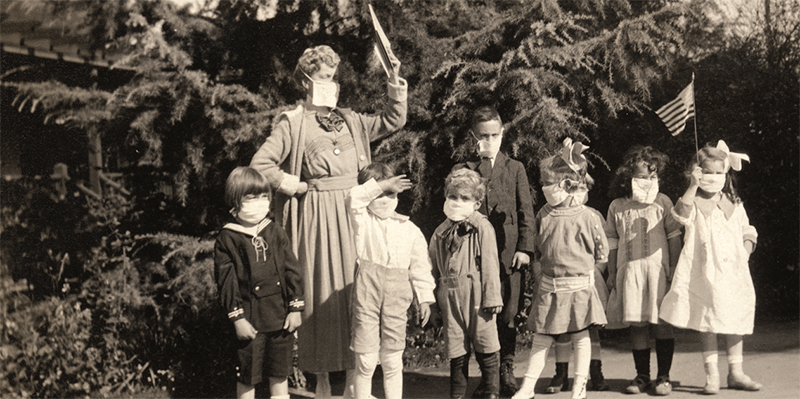By PAHA Historian Steve Staiger and PAHA Board member Leslie Mills
Photo: Mrs. Armour and her students at Castilleja School celebrate the end of the war while wearing flu masks, 1919 courtesy of Castilleja School
It is likely that more Americans have heard of the 1918 influenza pandemic in the last six months than in the previous 100 years. The story of the 1918 influenza pandemic is one of the most interesting events in our national history, yet it has remained hidden for generations.
It is believed the virus began with a cross-species transmission between livestock (possibly cattle or swine) and humans on the plains of Kansas. Several young Kansas farmers arrived at a U.S. army training camp at Fort Riley with the germs, and it spread across the nation as soldiers moved from camp to camp in preparation of being loaded on troopships and sailing off to the European battle grounds of World War I.
The influenza quickly spread across Europe, infecting thousands of soldiers on both sides of the war. Eventually, more American soldiers died from the virus than from casualties on the battlefield.
The virus became known as the “Spanish Flu” because as it spread across Europe, the Spanish press reported its devastating effect on the Spanish population. The influenza spread equally throughout Britain, France, and Germany with equal devastation, but wartime censorship limited press coverage in those countries at war. Spain was neutral in World War I, thus getting the blame, and the name.
In the United States, the influenza eventually spread from coast to coast. Its spread was much slower than the current coronavirus, and the west coast did not feel the effect for several months. Except for a limited number of business and pleasure travelers, most Americans in 1918 did not normally travel more than 100 miles from their home. The new exception was soldiers, and they generally traveled to the east coast on their way to the war front in Europe.
The first case of the virus in San Francisco was reported on September 4, 1918, and within three weeks, the entire Bay Area was in the midst of an epidemic. Patients began to fill the infirmary at Camp Fremont (the army’s training camp in Menlo Park), then Palo Alto’s Peninsula Hospital, and Stanford’s Isolation Hospital. At Stanford campus, those affected were said to be promptly isolated and hospitalized and had lower percent mortality than elsewhere. Between 1918 and 1919, the last year of World War I, the Spanish Flu killed an estimated 50 million people, or 3 to 5% of the world’s population. The war killed around 16 million people.
That year, the flu took the lives of 131 San Mateo County residents, accounting for one out of every six deaths in the county. However, this did not account for Camp Fremont where the Journal of American Medical Association reported a “conservative estimate” of 147 deaths out of 3,000 cases. The influenza killed at least 13,340 people that year in California. The Bay Area counties saw deaths of 6,000 people by Jan. 1919.
When the epidemic reached Palo Alto in the fall of 1918, attempts to control the spread of the virus included wearing of masks as well as closures of public schools. The construction of the new Paly high school had been completed, but because of the closures, students were still at home. When the epidemic subsided, the community celebrated the opening of the new high school. On Christmas Eve 1918, they marched from the old high school on Channing Avenue to the new location on El Camino and Embarcadero. In 2018, we celebrated the centennial of that event with a repeat of the march.
As with all local history organizations, the archives will continue to document the current coronavirus pandemic and its effect on Palo Altans.
Originally printed in the May 2020 newsletter of the Palo Alto Historical Association, Volume 43, No 7

